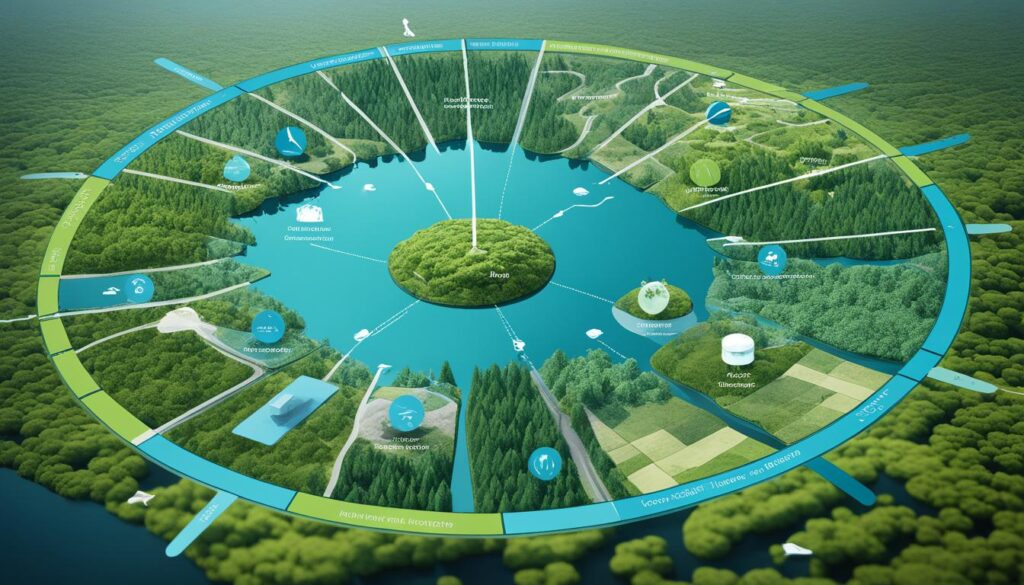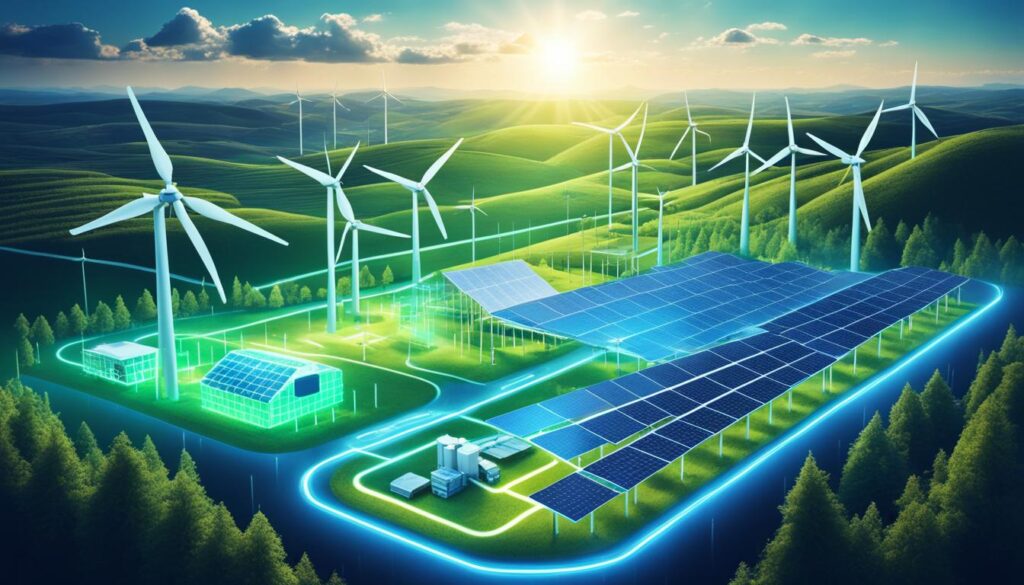“As an Amazon Associate I earn from qualifying purchases.” .
Imagine a world where the dangers of rising temperatures and unpredictable weather patterns could be managed and mitigated through the advanced powers of artificial intelligence (AI). As part of our dedicated effort, AI Climate Research harnesses this smart technology not just to confront but to curtail the impacts of climate change. By embedding AI into climatic initiatives, we aim to forge a path toward sustainability, pioneering efforts that heighten our planet’s resilience.
Leveraging technology in AI Climate Research turns vast data into actionable insights, leading to smart decisions that underpin sustainability efforts across the globe. This remarkable intersection of technology and environmental science offers hope and practical solutions to one of the most pressing issues of our times. It opens a gateway to a sustainable future, where technology and nature exist in harmony, safeguarding our planet for future generations.
Key Takeaways
- Understanding the profound impact of AI Climate Research on global sustainability.
- Insight into how AI assists in precise monitoring and analysis of environmental changes.
- Exploration of AI’s role in enhancing the performance and predictability of renewable energy sources.
- Enhancing community resilience and food security through AI-driven tools.
- AI’s significant contribution to carbon emissions reduction and improved energy management.
The Critical Role of Artificial Intelligence in Addressing Climate Challenges
In our fast-changing world, Artificial Intelligence (AI) leads in tackling Climate Challenges. It helps us create a Sustainable Future. By using AI, we can change how we handle environmental problems and understand nature better.
AI shines when dealing with lots of data, especially in managing climate issues. It helps us get ready for and deal with changes in the environment. By adopting AI, we make collecting and analyzing climate data better. We also get better at foreseeing and lessening the effects of climate change.
- AI has improved how we predict future events, letting us plan ahead more effectively.
- Thanks to AI, countries can come up with plans that fit their specific environments and social conditions better.
The mix of AI and action against climate change also makes managing resources better. In farming, where lack of water is a big problem, AI-based watering systems make sure we use water wisely. This helps keep farms going even in dry places. It also keeps people’s jobs safe and makes communities stronger in areas at risk.
AI also helps us get ready for and handle natural disasters better. It uses advanced algorithms to predict and respond to such events with more accuracy. This saves lives and cuts down on money lost. The Bezos Earth Fund giving $100 million shows the world believes in AI’s role in fighting climate change.
Take clean energy as an example: even with a lot of investment, not enough is going to developing countries. AI can make renewable energy work better in these places. This makes the sharing of technology’s gains fairer.
“AI does not merely support existing strategies; it innovates them, allowing us to tackle Climate Challenges not just with hope, but with competence and anticipation.”
Using AI actively is vital for those dedicated to solving the world’s Climate Challenges and achieving a Sustainable Future. AI has many uses, from shaping climate policy to handling disasters and promoting sustainable growth worldwide.
Environmental Data Analysis: How AI Enhances Understanding of Our Ecosystem
Today, understanding complex ecosystems is key as climate and ecological balances are at risk. AI and Environmental Data Analysis are changing the way we see and engage with nature.
Advanced Prediction and Monitoring Through AI
AI is changing how we predict and monitor the environment. It uses big data and machine learning to analyze information from satellites, sensors, and past records. This helps forecast things like climate change effects, water levels, and pollution.
For instance, AI forecasts which places might break environmental laws. This helps optimize the use of inspection resources. It’s crucial for keeping our ecosystems healthy.
Assessing Biodiversity and Ecosystem Health
Biodiversity tells us about an ecosystem’s health. AI helps quickly assess this by evaluating data from surveys and sensors. This real-time analysis points out problems like loss of species or habitat damage.
Initiatives like Microsoft’s AI for Earth and USC’s PAWS program use AI. They predict and fight against threats to biodiversity.

AI’s new technologies let us take a wider, more integrated approach to managing the environment. AI aids in conservation and offers essential data for making informed decisions and managing natural resources well.
In summary, AI in Environmental Data Analysis greatly improves our understanding and ability to act within ecosystems. It enhances regulations and promotes sustainable practices for protecting our planet’s diversity.
Climate Modeling: AI’s Contribution to Accurate Climate Predictions
Climate modeling is key to predicting future climate trends. Thanks to AI, these predictions are now more accurate. AI analyzes huge amounts of data from sources like satellites and weather stations. This helps researchers prepare for changes that could affect our world.
- AI can deeply examine climate dynamics, finding patterns that predict weather extremes or sea level changes.
- Deep learning and neural networks improve these models, making them more reliable.
- AI also makes simulation faster. This allows for complex predictions that used to take a lot longer.
Predictions are crucial for practical uses. They inform agriculture, water management, urban planning, and disaster preparedness. All sectors can now adjust to climate changes more effectively and confidently.
AI-driven climate models also protect the environment. They offer insights for conservation and resource management. This helps preserve biodiversity and habitats amid climate change.
| Year | Market Value | Forecast Value |
|---|---|---|
| 2022 | USD 2.8 billion | — |
| 2030 | — | USD 10.3 billion |
The growth in AI for climate modeling shows how crucial it is for addressing climate challenges. As technology evolves, combining efforts across fields is key. This will promote the ethical use of AI in climate research. And lead to innovations that change our approach to fighting climate change.
Renewable Energy Forecasting: Integrating AI for Cleaner Energy Solutions
AI is changing how we forecast renewable energy, making clean energy solutions better globally. It uses advanced machine learning to change energy production, storage, and management. This means a future with sustainable and efficient energy.
Optimizing Solar and Wind Power Outputs with AI
AI is making a big impact in solar and wind power. It uses predictive analytics to forecast power outputs very accurately. This helps manage the power grid better and ensures we have energy when we need it. For example, the US Department of Energy uses AI to make solar energy forecasting 30% more accurate, which helps utility providers a lot.
Improving Energy Storage and Efficiency through Machine Learning
Storing energy well is key to dealing with the ups and downs of renewable energy. AI helps by making battery systems better and predicting how much energy we’ll use. This makes using energy more efficient. Companies like BluWave AI are leading the way, adding AI to microgrids to improve how we distribute and manage energy. By 2030, the energy storage sector is expected to grow twenty times because of AI.
The world is investing a lot in AI for clean energy, expecting it to grow to $75.82 billion by 2030. This shows that more money and effort are going into using AI for renewable energy, which is making our energy cleaner and more sustainable.

| Region | Investment in AI (Billion $) | Expected Growth Rate |
|---|---|---|
| Global | $75.82 | 27.9% |
| USA | Significant | Up to 30% improvement in forecasting |
| Australia | Investing in AI solutions | 80% accuracy in wind forecasts |
AI is key to making renewable energy forecasting and management better. It’s leading us into a cleaner energy future. This will make our energy system more sustainable and reliable for the next generations.
Emission Reduction Strategies: The AI Approach to a Low-Carbon Future
The fight against climate change needs new ideas more than ever. AI stands at the forefront, offering groundbreaking solutions for a low-carbon future. In this section, we explore how AI technologies are changing energy production, transportation, and industrial processes to reduce carbon emissions.
AI quickly makes sense of huge amounts of data to help cut emissions in various fields. It makes smart grids more energy-efficient and self-driving cars more effective. Plus, AI’s ability to predict energy needs helps avoid unnecessary CO2 production.
In transportation, AI technologies improve route planning and traffic management, cutting down idle times and emissions. In energy-hungry industries, AI helps machinery run more efficiently. This reduces energy use and lowers the carbon footprint.
AI also monitors our environment and aids in climate change research. It predicts weather patterns and climate changes, helping us prepare better. This is crucial for fighting climate change.
The table below shows how AI is making a difference in reducing emissions:
| AI Application | Impact | Percentage Reduction in Emissions |
|---|---|---|
| Smart Grids | Energy optimization | 30% |
| Autonomous Vehicles | Route and traffic efficiency | 50% by 2050 |
| Predictive Maintenance | Industrial energy efficiency | 25% |
| Crop Irrigation | Water usage reduction | 20% |

AI is not just making our systems more efficient; it’s opening new paths to a sustainable future. Including AI in emission reduction strategies is crucial for our planet’s health.
AI Climate Research: Pioneering an Era of Eco-innovation
AI Climate Research is more than a new area of science. It blends cutting-edge tech with the urgent need for sustainability in tackling global climate issues. This approach uses AI to analyze data and improve processes. It paves the way for eco-friendly innovations.
Eco-innovation through AI touches many areas like renewable energy, farming, and reducing waste. It helps make smart choices quickly, leading to better and more efficient solutions.
AI changes how we manage and share energy. For example, AI-driven smart grids help distribute energy more efficiently, cutting waste and supporting renewable sources. This improves power systems everywhere, making them more eco-friendly and reliable.
| Technology | Impact on Sustainability |
|---|---|
| AI-driven Smart Grids | Optimizes energy distribution, reduces waste, promotes renewable energy integration |
| ProGen AI Models | Creates compostable materials, reducing plastic waste and greenhouse emissions |
| AI in Agriculture | Minimizes use of pesticides/fertilizers, enhances yield using precision farming |
| AI for Weather Prediction | Improves renewable energy production by predicting precise weather patterns |
AI Climate Research also leads to inventions like ProGen AI. This project turns things like carrot starches into biodegradable materials. It offers sustainable alternatives and cuts down on non-renewable resources’ use and environmental harm.
The adaptability of AI in various fields shows its huge potential for eco-innovation globally. AI helps in farming with precision agriculture techniques and in manufacturing by reducing emissions. As we tackle climate issues, combining AI with eco-friendly innovations will be key. It will help turn challenges into chances for a greener future.
Sustainable Agriculture: Leveraging AI for Food Security and Climate Resilience
In our world, sustainable agriculture is a must for food security and climate resilience. The use of AI helps farmers and agronomists make smart, conservation-led choices. This leads to better, more sustainable ways to manage crops.
Data-Driven Farming Techniques
AI-driven farming changes how we use resources like water and fertilizers. It uses advanced analytics and machine learning. This improves how we water crops, use fertilizers, and handle pests. It reduces waste and boosts crop quality and yield.
For instance, AI can predict climate trends. This lets farmers quickly adjust to weather changes. It protects crops from harm.
Water Resources Management with AI
Managing water well is key to keeping farms productive. AI helps by predicting when it will rain and checking soil moisture. It also makes watering systems smart. These tools make sure crops get just what they need, saving water and helping the environment.
This careful water use helps crops grow better. It also cuts down on water use in dry places.
AI in farming is doing more than just improving food security. It’s also boosting economies, like the UK’s GDP growth. AI is changing agriculture in big ways. It’s helping us reach our 2030 Sustainable Development Goals. This includes fighting pests better, using resources wisely, and handling weather changes.
With AI, agriculture is becoming more productive, sustainable, and tough. This supports global efforts to fight climate change and increase food security worldwide.
Geospatial Analytics: Tracking Climate Impacts with Precision
In the world of saving our environment and managing the climate, Geospatial Analytics is key. It uses advanced AI tools to closely monitor and study Climate Impacts. This tech can track how cities become hotter or check if tree planting works well. The detailed information helps make important environmental policies.
IBM works with NASA to use huge amounts of data from space to face environmental issues. This teamwork helps study hot cities, achieving a cool-down of 3°C in the UAE. It shows how tech and environmental science can work together for a better planet.
| Project | Location | Outcome |
|---|---|---|
| Urban Heat Islands Analysis | UAE | Temperature reduction by >3°C |
| National Tree Growing Campaign | Kenya | Planting 15 billion trees by 2032 |
| Climate Risk Assessment Automation | UK | Initiative focusing on aviation sector |
Geospatial Analytics does more than just measure Climate Impacts. It helps in making smart decisions. For example, IBM’s method in Kenya aims to fight deforestation. It supports a massive tree planting project to address water shortages in key areas.
Looking at the UK, Geospatial Analytics helps understand flood risks for many properties. With flood risks likely to double, accurate predictions are crucial. This precision is essential for safety and planning.
By reducing flood risks and ensuring tree projects work, Geospatial Analytics brings together the latest tech and care for the planet. It lights the way to a sustainable future through smart actions and technology.
Embracing the Ethical Implications of AI in Climate Strategies
Integrating AI into our climate plans means we need to think about ethics. AI helps us tackle climate change and improve sustainability. However, it also brings up important ethical issues. We need to deal with these to ensure that AI benefits everyone.
Promoting Transparency and Fairness in AI Applications
Making AI transparent and fair in climate efforts is key. These technologies must follow rules that prevent increasing social inequalities. Unbiased algorithms are critical for analyzing big data. This helps manage resources better or predict disasters in a fair way. But, we must design AI that doesn’t worsen biases that harm vulnerable groups.
Tackling the Energy Consumption of AI Technologies
AI’s energy use is a big ethical issue. Although AI can help combine renewable energy sources into smart grids, they can also use a lot of energy. We must create AI that’s efficient and doesn’t add too much to the carbon footprint.
This table shows how AI can be good and bad for climate strategies:
| AI Application | Positive Impact | Negative Concern | Strategic Response |
|---|---|---|---|
| Early Warning Systems | Predicting extreme climate events | High energy consumption | Increase algorithm efficiency |
| Resource Management | Enhanced water and energy efficiency | Risk of data privacy violations | Implement robust data governance |
| Smart Agriculture | Optimized crop yields and irrigation | Potential for exacerbating inequalities | Ensure accessibility and equity |
In dealing with ethical implications of AI, policy-making is crucial. By working together internationally and promoting inclusivity, AI can be a positive force. It can lead us to find new solutions for sustainability and fairness in environmental efforts.
Conclusion
Exploring AI Climate Research shows its key role in making our planet healthier. By using AI, we’ve gotten better at predicting weather patterns and finding ways to protect our environment. This tech has helped increase food production, made energy use smarter, and improved our understanding of the climate. All of these steps lead us toward a more sustainable world that meets global environmental goals.
But using AI to fight climate change isn’t just about the tech. It’s about making sure we do it ethically and responsibly. We need to be open about how AI works and its effect on the planet. And we have to make sure it doesn’t use too much energy or make inequality worse. Keeping an eye on these things will make sure AI helps, not hurts, our environment.
To fully use AI in climate work, everyone needs to work together. Scientists, lawmakers, and regular people all have a role in making sure we use AI in a way that’s both smart and fair. This teamwork can create a future where we’re better prepared for climate challenges. With AI, we have a chance to not just make our lives easier but also to make a real difference in the fight against global warming.
FAQ
What is AI Climate Research?
How does AI contribute to addressing climate challenges?
What is the role of Environmental Data Analysis in AI Climate Research?
How does AI enhance climate modeling?
How does AI integrate with renewable energy forecasting?
How does AI help in reducing greenhouse gas emissions?
What are some groundbreaking initiatives in AI Climate Research?
How does AI enhance sustainable agriculture?
What is the role of geospatial analytics in AI Climate Research?
What are the ethical implications of AI in climate strategies?
Source Links
- https://www.linkedin.com/pulse/ai-climate-change-leveraging-technology-address-dave-balroop-rhkic
- https://www.tractiontechnology.com/blog/ai-and-climate-change-pioneering-technologies-for-a-sustainable-future
- https://research.google/teams/climate-and-sustainability/
- https://www.undp.org/arab-states/events/critical-role-artificial-intelligence-responding-climate-crisis
- https://press.un.org/en/2024/ecosoc7162.doc.htm
- https://blog.google/outreach-initiatives/sustainability/report-ai-sustainability-google-cop28/
- https://environment.upenn.edu/events-insights/news/ai-and-environmental-challenges
- https://news.climate.columbia.edu/2018/06/05/artificial-intelligence-climate-environment/
- https://www.unep.org/news-and-stories/story/how-artificial-intelligence-helping-tackle-environmental-challenges
- https://blog.emb.global/ai-in-predicting-climate-change-patterns/
- https://www.linkedin.com/pulse/how-does-ai-impact-climate-modeling-ai-news
- https://www.linkedin.com/pulse/ais-pioneering-impact-climate-modeling-prediction-market-qt0wf?trk=article-ssr-frontend-pulse_more-articles_related-content-card
- https://www.linkedin.com/pulse/ai-renewable-energy-powering-up-greener-tomorrow-neil-sahota
- https://www.nature.com/articles/d41586-024-00780-8
- https://www.frontiersin.org/research-topics/40836/artificial-intelligence-applications-in-reduction-of-carbon-emissions-step-towards-sustainable-environment/magazine
- https://education.cfr.org/learn/reading/how-can-artificial-intelligence-combat-climate-change
- https://engineering.salesforce.com/unveiling-salesforces-blueprint-for-sustainable-ai-where-responsibility-meets-innovation/
- https://www.linkedin.com/pulse/harnessing-power-ai-sustainable-agriculture-arensic-age7e
- https://www.frontiersin.org/articles/10.3389/frai.2024.1328530
- https://medium.com/@tshilidzimarwala/ai-and-sustainable-development-in-agriculture-d9b54ff2df81
- https://newsroom.ibm.com/2023-11-30-IBM-Advances-Geospatial-AI-to-Address-Climate-Challenges
- https://www.wovenware.com/blog/2024/04/geospatial-ai-services-monitoring-environmental-changes-and-climate-impact/
- https://trado.medium.com/the-ethics-of-ai-in-climate-change-ensuring-fair-and-equitable-solutions-023b7331ad88
- https://www.emerald.com/insight/content/doi/10.1108/JICES-11-2021-0106/full/html
- https://link.springer.com/article/10.1007/s10311-023-01617-y
“As an Amazon Associate I earn from qualifying purchases.” .



